A History of Violence in the Caucasus
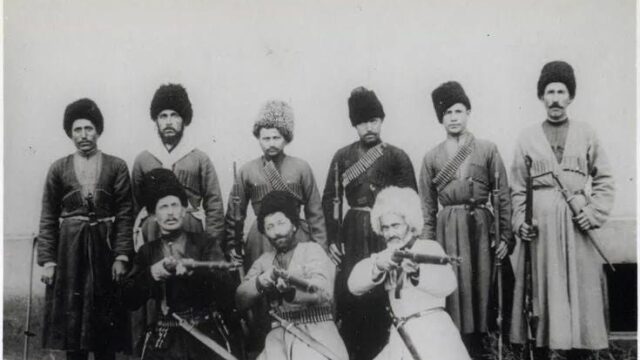
Richard Wilson details the long history of the peoples of the Caucasus, a region marked by imperial invasions, shifting alliances, ethnolinguistic complexity, and martial traditions rooted in mountainous terrain and ancestral codes of honor.
Since we may boast that his blood is spilt, I will tell you all from the beginning; prepare to listen.
— Shota Rustaveli, The Knight in the Panther’s Skin
Whoever fears anyone other than Allah is not a man.
— Imam Shamil
The Dream of Soghomon Tehlerian, assassin of Tallat Pasha, one of the main organizers of the Armenian Genocide: His mother’s corpse arose before him. He told her, “I saw Talaat.” His mother answered, “You saw Talaat, and you did not avenge your mother’s, father’s, brothers’, and sisters’ murders? You are no longer my son.” This is the moment when the defendant thought, “I have to do something. I want to be my mother’s son again. She cannot turn me away when I go to be with her in heaven. I want her to clasp me to her bosom like before.”
Only war can repulse war.
— Abkhazian proverb
The following is by no means a detailed history; it’s a summary, my summary, of connections, real and imagined, between the peoples of the Transcaucasus Region. The connections are the mountains and violence, not for the sake of violence, but violence for protection, honor, family, and nation, to survive. If you would like to go further, there are many books with a longer summary of the region’s history. If you want a detailed history of this land, there is only one book, the two volumes, History of the Caucasus by Christoph Baumer.
This land, until early last century, had the second largest tigers on earth; it still has hyenas; it had moose; it had lions until the 10th century. It has wolves, brown bears, jaguars, eagles, falcons, water buffaloes, red deer, poisonous snakes, and their own Bigfoot, the alma/almasty. Looking at the above list, one can see the mix of northern — moose, with southern — water buffalo and hyena, lion. There are massive Caucasian Mountain Dogs. The mountains rise all around, the tallest in Europe. There are languages, so many languages; nothing is easy, and so their songs are sad, and their lezginka dances are lively. The men wear the papakha, the black or white sheep hat made famous by Khabib Nurmagomedov and lately by Merab Dvalishvili. Men wearing the chugha/chokha/cherkeska, a woolen coat/cloak with visible bullet/charge cases called gazyrs. Depending on where you were in the Caucasus, the man coming towards you with the chokha, wearing a papakha, had a dagger, a sabre, pistols, or all of the above. If he somehow lost his weapons, highly unlikely, he had hand-to-hand combat training to kill you; within this training was striking and wrestling; training he most likely did since he was a small child. In the high altitude. The odds were against you — you would surrender or die.
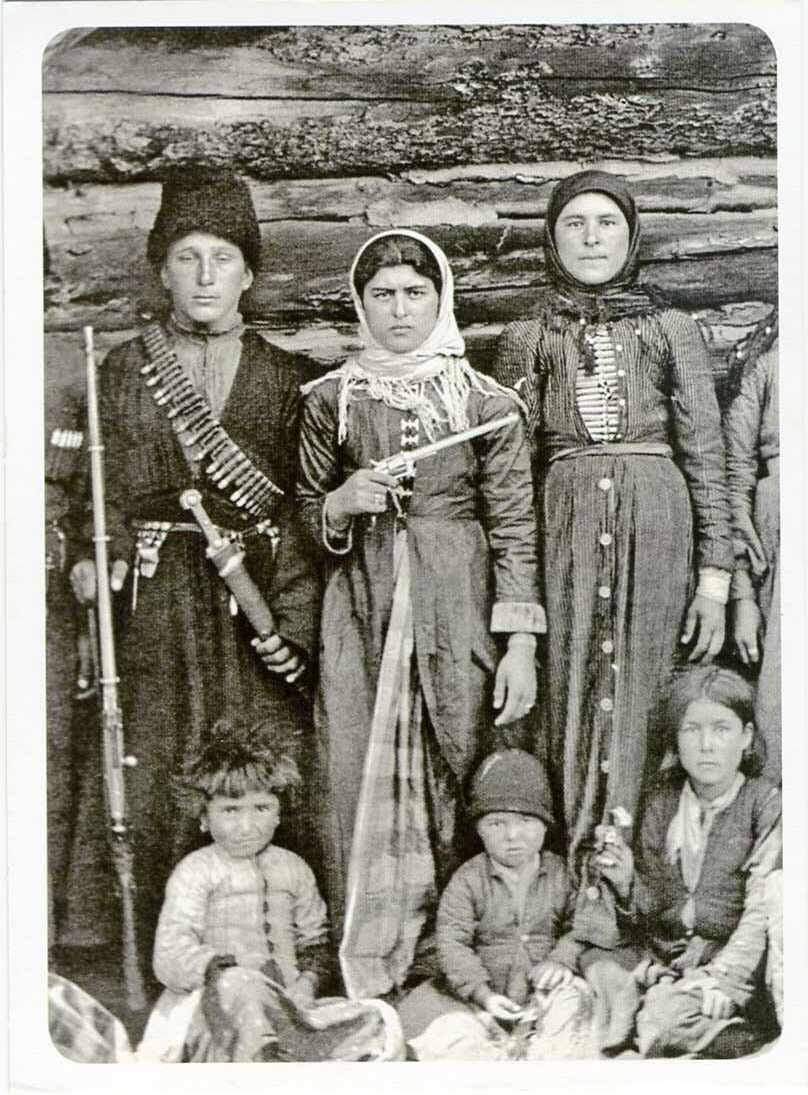
This land, roughly the size of Poland, the South Caucasus and North Caucasus together, Transcaucasia for the South, Ciscaucasia for the North, is a land of wars, battles, invasions, guerilla wars, revenge, blood feuds, and violence that crosses all religious lines, all ethnic lines, and all language barriers. It’s often said that the Thirty Years’ War was the third greatest military catastrophe for Central Europe; World Wars Two and One, respectively, are the deadliest by numbers. The Black Death, though, was the greatest disaster in European history, erasing 60% of the total population. The Thirty Years’ War. Three decades of conflict. That’s long; however, the Caucasus region has been at war since Assyrian King Shalmaneser I (r. 1275/74–1244 or 1263–1234 BCE). This is the first recorded instance of aggression against the Caucasus. The first known instance of the outside world invading the region. The Assyrian king, after conducting a campaign to Uruatri in his first year of reign:
“I conquered […] eight lands and their fighting forces; fifty-one of their cities I destroyed […] I subdued all of the land of Uruatri.”1
That is, as far as we know, the region of the earth that has been in conflict the longest. Since the time of the Ayyubid Empire, every empire in Eurasia, in Western Asia, and many in Europe, the Arabs and Mongols, the Nazis, and the Russians have come here to establish themselves as the preeminent power, or to exact tax, or to take men and women as slaves. It is an incessant violence.
This is true of most mountain peoples, resistant to change, to outsiders, and fierce holy madness of violence thrown at the invader: Pashtuns, Montenegrins, Albanians, Yemenis, Scottish, Appalachian Americans, and Caucasian peoples. Roughly half of the British Empire’s army consisted of Scottish and Irish soldiers (W. Farr, writing in The Journal of the United Service Institution, was clear that it would be a “mistake” to think of the “English” army as “simple Anglo-Saxons.” He noted that the number from England (67,647) was about the same as that born in Scotland (15,300) and Ireland (53,169) put together.2
The majority of the Armed Forces of the USA were the Whites of the Appalachian region and the South. And, of course, the same can be said of the Caucasus Region: more men from this region have served in the military than men from other regions of their respective countries. Some of the best warriors the world has ever known have been from here. Suvorov, half Armenian. Bagration, Georgian. Imam Shamil, Avar. The Circassians have been prominent in the Ottoman Empire army in Egypt, Syria, and especially Jordan, which, when they first moved there, was part of the Ottoman Empire.

The idea that some peoples are more martial than others is ancient. Hippocrates himself suggested that “the pusillanimity and cowardice of the inhabitants” of Asia and their “unwarlike” character were partly due to “the nature of the seasons” and that tribes in Europe from areas that were “mountainous , rugged, elevated, and well-watered, and where the changes of the seasons are very great” were likely to be of a “warlike disposition … and … apt to have no little of the savage and ferocious in their nature.”3
The Tsar’s soldiers who manned the outposts along the southern border of the Caucasus were usually Cossacks. Having been in close proximity to the fearsome Caucasian fighters, they adopted the dress of the Caucasus: the hat, the jacket, and the boots. In Tolstoy’s The Cossacks:
“Living among the Chechens, the Cossacks intermarried with them and adopted the manners and customs of the hill tribes, though they still retained the Russian language in all its purity, as well as their Old Faith.”4
War, battle, and violence were in the DNA of every Caucasian tribe. It came from their land, drenched in the blood of ancient ancestors, even brothers and fathers. An old Persian saying says, “That Shah is a fool who wages war on Dagestan.” Over the centuries, too many fools have come to fight them; maybe they win for a spell, for even centuries; eventually they leave again. And then another comes. And, in between, the occupations? Well, they fought among themselves, of course! Nation vs. neighboring nation, region vs. region, tribe vs. tribe, or a confusion of all against all. Even the women of these mountain people fought. The idea of the Amazon warriors comes from the Caucasus. The myth of Prometheus, who every day is chained to Mt. Kazbek, and an eagle flies down to rip apart his liver, flies away, only to return the next day to eat the new liver, ad infinitum. The land that nourished the people was violent. A harsh, unforgiving land nearly incapable of agriculture on a large scale. A plow or a sword? Here, a man has had very little choice or time to think… the sword is picked up.

In this climate of drama, where vengeance was the first principle, weapons were personified, taking on a character, an entity of their own. I was made for Ammalet Beg, says one blade… No Caucasian man was properly dressed without his kindjal. Women, too, wore a smaller but scarcely less formidable dagger, thrust through their waist belt. The kindjal was used slashingly. ‘The cut’ was de rigueur. To kill with the point lacked artistry. Weapons were a cult, as dear as honor itself.5
— Lesley Blanch, The Sabres of Paradise: Conquest and Vengeance in the Caucasus
In 1900, if someone asked where the most troubled part of Europe was, they’d probably have said the Balkans; the entire area was a wasp’s nest, or a “powder keg.” Indeed, the many years of heated rhetoric, threats, and counter-threats made all of Europe ready to blow; then Sarajevo happened, and Europe went up in flames. The Balkans was a crossroads of colonial powers, the Ottomans, the Habsburgs, small principalities, enclaves, exclaves, ancient hatreds, and new ones. The martial abilities of the Serbs and especially the Montenegrins were prized by the Ottoman Empire; the boys were sought after for the Janissary system. Even Hitler, apocryphal though it is, is reported to have said, If I had ten armies made of Serbs, I could take over the planet.
But, go east, and there is another area, the Caucasus region, between the Black and Caspian Seas, between Russia and Turkey and Iran. An area as much a powder keg as the Balkans ever was. The Caucasus still is a powder keg. The last few years have seen protests in Tbilisi — they happen now — protests in Armenia, protests in Abkhazia, an Azeri/Armenian war, and going back a couple of decades, there has been the simmering conflict between Armenia and Azerbaijan over Nagorno-Karabakh, the Russian Chechen Wars (First Russo-Chechen War, 1994-1996, and Second Russo-Chechen War, 1999-2009), war between Russia and Georgia, conflicts between Abkhazia and Georgia, Ossetia and Georgia, etc.
The Caucasus can rightly be called the powder keg of Europe, of Asia, and of the Middle East. Pick one, pick all. After the Yugoslav War, the Balkans are quiet, with an occasional grumble from the Republika Srpska or Bosniaks, but overall the Croats, Slovenes, Serbs, Bosnians, Montenegrins, and Macedonians, even the Kosovar Albanians, have become fat with a new EU reality; the largesse of being petit bourgeois has given them an outbreak of yawns, instead of an outbreak of explosions and attentats. Not so the Caucasus.
Where to begin? First, the name. Caucasus. Some say it means mountains or hills or heaps; some say land of seagulls. Still others murmur that the ancient name of the founder of a race of Caucasians, the oldest Caucasians, was Kavkaz. Whatever the case, the adjectival form became synonymous with white people in the West. In Russia and the CIS, they don’t say this; a Caucasian is a native of the Caucasus Mountain region. Westerners have Johann Blumenbach, famous anthropologist of Göttingen University, to thank for this, back in 1785. He believed that the origin of the white race was in the Caucasus region.

Blumenbach: “I have taken the name of this variety from Mount Caucasus, both because its neighborhood, and especially its southern slope, produces the most beautiful race of men, I mean the Georgians.”6
He wasn’t too far off. Recent genetic discoveries show that blue-eyed people began in the northern Black Sea region, not too far from the Caucasus. The physical attributes associated with whites, namely tall, pale skin, blonde hair, and blue eyes, come from the Victorian-era obsession with Circassian women, who were coveted by harems in the Muslim world for a couple of hundred years. These attributes were not just associated with us whites, but the blue eyes, the blonde hair, the skin color — these were held as the best physical characteristics of any white man, a “Caucasian,” if you will, and thus, of all humanity. At the top, blonde hair, blue eyes, white skin. Below that? Everything else.
Mark Twain describes seeing white Circassian women being sold in Constantinople. In his Innocents Abroad, he imagines what an American newspaper advertisement would say regarding a slave sale of whites:
…if the American metropolitan newspapers were published here in Constantinople, their next commercial report would read about as follows, I suppose:
SLAVE GIRL MARKET REPORT.
‘Best brands Circassians, crop of 1850, L200; 1852, L250; 1854, L300. Best brands Georgian, none in market; second quality, 1851, L180. Nineteen fair to middling Wallachian girls offered at L130 @ 150, but no takers; sixteen prime A1 sold in small lots to close out — terms private.
‘Sales of one lot of Circassians, prime to good, 1852 to 1854, at L240 @ 242, buyer 30; one forty-niner — damaged — at L23, seller ten, no deposit. Several Georgians, fancy brands, 1852, changed hands to fill orders. The Georgians now on hand are mostly last year’s crop, which was unusually poor. The new crop is a little backward, but will be coming in shortly. 7
In many countries of Europe and the diaspora, Circassians were seen as the number one white people, and whites were viewed as the top human specimens. The white person par excellence. The women, beautiful and dignified, the men, stately and masculine. But not all Caucasians (the mountain region and the people) are “Aryan”-looking. Some look Semitic, with dark features, small, big bones, and dark eyes; some are tall, lithe, with pale skin and either blue eyes or black. Some look Turkic, Mediterranean, Levantine, or Mongolian (the Nogai Horde remnant population live in Dagestan and have become “Caucasianized”). I once saw a Chechen woman in Dagestan, tall, with blonde hair and the bluest eyes. Not a drop of Slav blood. I’ve seen blonde Abkhaz, Georgians, and Ossetians. And, darker-skinned types, with dark eyes, all sorts. Every skin tone, except black, every eye color.
The Mamluks were slaves of Egypt; these were boys stolen from Circassia or Georgia and then trained in fighting, in war — like the Janissaries of the Ottoman Empire, who were stolen from Montenegro and Serbia. But the Mamelukes are the most successful slave rebellion in history. They went from being slave mercenaries to rulers of an empire. No, not just one empire but many empires and sultanates.
By the 14th century, most slaves from the Caucasus used in the Mamluk system in Egypt and elsewhere were Circassian. By the 17th century, Georgians were introduced on a large scale. By 1811, the system was all but dead; in Libya, it lasted until the Libyan-Italian War in 1920.
Then, a “Georgian” slave could have been a Dagestani, an Avar, a Chechen, an Armenian, or a Circassian. An “Armenian” could have been an Azeri, an Abkhaz, a Georgian, an Avar, a Dagestani, or any of the above; any of the above could be lumped together as a Russian, or whatever the main ethnicity is in your Caucasian country; you may be lumped in with them. Sometimes, even the descendants don’t really know what they are. When the Russians began their push into the North Caucasus, they called every person either Circassian or Tartar. So, going back in history, a man the outside world called Circassian could have been Avar, Tat, Lezgin, Azeri, Chechen, or anything else. Saladin, for example, was a Kurdish Muslim from Armenia. It’s likely that some called him Armenian, and some called him Arab. Or Avar, Lezgin, Assyrian, etc. And still many more have had their ethnicity subsumed or erased by outside powers.

The people here call it the Kavkaz. In all the many languages of this region, it is “Kavkaz.” Between Asia and Europe. South of it is the Middle East; north of it is Russia. Most of it is not arable; it is mountainous. Inside this region, which some have called the land of languages, it is chaotic…
This ethnolinguistic diversity is a veritable Tower of Babel and was already a challenge for Greek and Roman traders. Strabo mentions that in the Greek colony town of Dioscurias, now Sukhumi on the northeast coast of the Black Sea, seventy different peoples converged with their own languages. Pliny speaks of 130 tribes, which is why the Roman merchants conducted their business ‘with the help of 130 interpreters.’
— Christoph Baumer, History of the Caucasus, Volume 1, p. 8.
Muslims, Christians, and Buddhists, and a very small number of pagans and Jews live here. Mountain Jews who speak an ancient Persian language [Judeo Tat/Juvani], who aren’t Sephardic or Ashkenazi but come from Persia — the Nazis apparently knew this and didn’t kill them, or didn’t kill that many, depending on the sources. The dominant Christian peoples are Georgian and Armenian in the South Caucasus; Islam is everywhere else; and native folk religions have extremely small numbers, as is expected.
Mostly, the pagans of the Caucasus live in Kabardino Balkaria. In the north, which is mostly Muslim, there are Christians in Ossetia.
Jews here are unlike Jews anywhere else; Jews elsewhere are famous/infamous for their bookishness, their focus on scholastic achievements. Here, a man is not a man who cannot fight. Here, where police and laws couldn’t penetrate, a man here must act as judge, jury, and executioner. A man not bound by honor wasn’t even a woman; he was nothing. This applies to men of all faiths or no faiths in the Caucasus. Some hypothesize that the Jews were sent by the Shah to guard the frontier in the Caucasus, maybe around the year 350. Like the Christians and Muslims of this region, they wore the papakha and the chokha; they wore weapons. Their food is identical to their Muslim and Christian neighbors.
In this land, between Europe and Asia, between 1513 and 1823, there were at least ten wars between the Persian and Ottoman Empires. The first war, the Battle of Chaldiran, was fought in what is now Iranian Azerbaijan, in the town of Chaldiran. Persia lost. In 1532-1555, the Safavid-Ottoman War again came to the Caucasus; armies laid waste to Armenia and Georgia, the locals and invaders converted, reconverted, massacred, revenged, assassinated, switched sides, and switched again. By 1555, the Persians lost much of their Caucasus holdings to the Ottomans. In 1603, the Safavids, seeing the Sublime Porte in turmoil with rebellions and wars, struck at the Caucasus. The new Shah, Abbas the Great, used his gholam army (consisting of Circassian and Georgian male slaves) to attack Tabriz, Azerbaijan. This gholam army was based on the Janissary system. They freed parts of modern-day Armenia and Georgia, the people of Yerevan and Tiflis welcoming them as liberators. The Persians then went on by 1612 to liberate more cities and territory, including Baku. The Ottomans sued for peace, and all of the Ottoman Caucasus territory was put under Persian suzerainty. In 1616 the Ottomans again declared war against Persia; they besieged Yerevan with the help of Georgian princes and their soldiers; however, the Shah’s commander in chief was a local Armenian, Qarachkay Khan (whose own commander in 1605 was the Georgian commander, Allahverdi Khan, the man who quintupled the gholam army by taking more Caucasian slaves). Unlike the Janissaries, the gholam soldiers’ possessions and honors could be passed on to one’s sons… The Ottomans and Persians would fight for two more centuries, namely over the Caucasus.

Enter Russia. Russia and Persia fought four wars because of the Caucasus. By 1813, Russia and Persia signed the Treaty of Gulistan. Persia ceded almost all of her Caucasian territory to Russia.
Dagestan, Mingrelia, Abkhazia, Derbent, Baku, Shaki, Quba, Talesh, Shirvan, Karabakh, and Ganja, went to Russia. They would fight one more war, and Persia would cede Yerevan and much of modern-day Armenia and southeastern Azerbaijan to Russia in the Treaty of Turkmenchay.
Let’s go back in time to 287 AD. King Trdat of Armenia wins the Olympic medal for wrestling. In 385, the future king of Armenia, Varazdat, won the gold for fist fighting, a sport then where fighters beat each other until one fell dead or unconscious. No weight classes. Leather straps around one’s fists.
Recently, the rise of Dagestani and Chechen fighters in the UFC has brought the limelight, again, to the Caucasus region; everyone has an answer as to why they are dominant. Warlike, religion, altitude. All true but not the complete picture. Georgians and Armenians are also dominant: Ilia Topuria and Merab Dvilishvili; then there is Arman Tsakryan, an Armenian. But the UFC isn’t the only combat sports organization. Bellator also is filled with Caucasians, mostly Dagestani. But, it’s not either of these two sports where Caucasians dominate, truly dominate. It’s wrestling. In Greco-Roman and freestyle wrestling, they dominate almost completely. Why? History may give an answer…
The ancient Caucasus, a region almost the size of Texas, with all of its bombast, all of its machismo is a rough land with a rough history. I’ve been to both places, the North Caucasus and Texas. In Dagestan, I felt as if every man, from 16-80, could beat me, and if he couldn’t, he’d stab me or shoot me. A janitor on the Caspian had fists like small hams and biceps; he must have been 65-70. Every day he asked in Russian, “Do you want to wrestle me, Yankee?” Even the cows of Dagestan seemed tough. In Yerevan and Tbilisi, in Pyotogorsk, near Elbrus, men seemed a little testy, ready to tussle; a Kipchak shepherd near Elbrus laughed at me and wanted to box. My only close shave with death in Moscow was a black Mercedes that rolled on the sidewalk behind me late at night. I barked and cursed, the driver’s side windows rolled down, and I could see four large Chechen men, all wearing black; nobody said anything. I stopped flapping my gums and saluted. I had no idea what else to do. Windows up, they slowly drove down the sidewalk. Owning it.
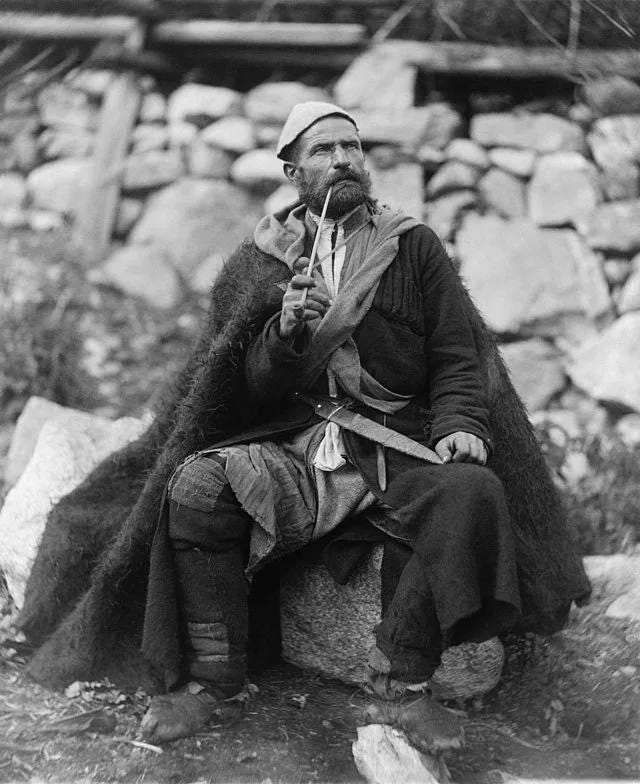
The Nart sagas, the ancient epic of the Caucasus: In these sagas are connections with King Arthur, the Norse gods, and Prometheus. Nart is a Persian word; in many Caucasian languages, nart means giant. This region was in the Persian sphere of influence for over 1000 years. In Baku and Tbilisi, there are still Zoroastrian temples; in Azerbaijan, azer, being a Persian word for fire, they still celebrate the Zoroastrian New Year. The Ossetians are descendants of Eastern Iranian Scythians. In Ossetia-Alania, Mithra was worshiped until the 2nd century CE. Since the 1980s, a resurrected Scythian neopaganism, Assianism, has flourished in Ossetia. In 2012, the Ossetian government stated that 29% of the total population was Scythian pagan. Some say it’s much higher, 55%. In the Northeast Caucasus, bordering Dagestan, are Europe’s only Buddhist people, the Kalmyks, with maybe 250,000 people. They replaced the earlier Nogai Mongols, who were Muslim and still remain in Dagestan. The Kalmyk steppe is the Urheimat of the Indo-European peoples.
In this rugged land of mountains and poetry, there is a chivalric code that still exists. Some say the Alans who came to France gave Europe this chivalric code. Slighted, words, a look, the Caucasus people are infamous for being impulsive, hotheaded, and violent but also magnanimous, even to one’s enemies. As strong as the machismo is here, the opposite, friendliness, deep, strong emotion to a stranger, to a guest, mitigates the high machismo. In all the Caucasus cultures, food and hospitality play an important role in the lives of these people.
This region of the highest mountains of Europe is the dividing line between Asia and Europe. It is also a dividing line between the South and the North. Persian influence was killed by the Russians in 1828. Ottoman influence continued a little longer. The Bolsheviks killed that. When coming to the region from the south, after the Caucasus, you are now in Russia, the largest nation — synonymous with frozen expanses. Coming from Russia, entering the region and going on, you’re now in the south, the Middle East. Coming from the west and moving past the region you’re now in Asia, from Asia, walking through and past, now you breathe European air. In a human body, we have high-stress regions; they’re usually large joints, say the hip. South of the hip are the thigh, calf, and foot; north are the lumbar region and back, shoulders, and brain. The Caucasus acts as a joint, a region of friction from all directions. Influences: monetary, religious, culinary, literary, martial, psychological. A man must protect, fight, and kill… and respect. Honor. You disrespect my family, you pay. Disrespect my people, you pay. Here, the centuries don’t throw back their hair; they rise up, above you, before you. They are the fortress and the obstacle; they create the clean air you drink with healthy lungs. Memories are long, very long… a Georgian sat and spoke of his land:
Land of Wolves…
In the words of Keith Hitchins/Encyclopedia Iranica:
Between the Achaemenid era and the beginning of the 19th century, Persia played a significant and, at times, decisive role in the history of the Georgian people. The Persian presence helped to shape political institutions, modify social structure and landholding, and enrich literature and culture. Persians also acted as a counterweight to other powerful forces in the region, notably the Romans (and Byzantines), the Ottoman Turks, and the Russians. But the Persian-Georgian relationship was by no means one-sided, for the Georgians contributed substantially to Persia’s military and administrative successes and even affected its social structure, especially under the Safavids.
Prominent Georgians were placed in the Safavid Empire, notably in the military. But it was Persia, since the time of the Achaemenid dynasty, that had a massive influence on Georgian society, most of Eastern Gurjistan (Persian for Georgia, meaning “land of the wolves”). The Persians, like every empire after them, had problems consolidating rule in the Caucasus. Mainly, it was Eastern Georgia under their control or suzerainty. Georgia itself isn’t just Georgians, or, as they call themselves, Kartvelians. Georgia wasn’t always Georgia; everything in the Caucasus is a maze, not only in space but in time and thought also. Ancient Georgia wasn’t Georgia but Colchis and Iberia in the east. Inside were Kartvelians, Mingrelians, Laz, Abkhaz, Kist (a Chechen tribe of today around 5,000), Ossetians, Greeks, Armenians, and Azeri, Yazidi, and Assyrians. Abkhazia has been part of Georgia for 1,000 years. In the Abkhazian language, it is “Apsny, Land of the Soul.” The Georgian language belongs to the Georgian language family and its dialects, Mingrelian, Laz, etc. Abkhazian is a northwest Caucasian language related to Circassian. They are not related or understandable, akin to Estonian and, say, Spanish.
Land of Mountains
Dagestan, its name is a construction of the Turkish word Dag (mountain) and the Persian stan, land of. In olden times, and ancient times, it was known as Lekia, Avaria, and Tarki. It consists mostly of Avars, then Dargins, Kumyks, Lezgins, Laks, Azeris, and Rutulians. And more. Its languages are Avar, Dargin, Kumyk, Lezgin, Lak, Tabasaran, Chechen, Ingush, Aghul, Nogai, Tat, and Tsakhur. And more, of course. The lingua franca is Russian. South is Azerbaijan; southwest is Georgia; west is Chechnya; north is Russia; east is the Caspian Sea.
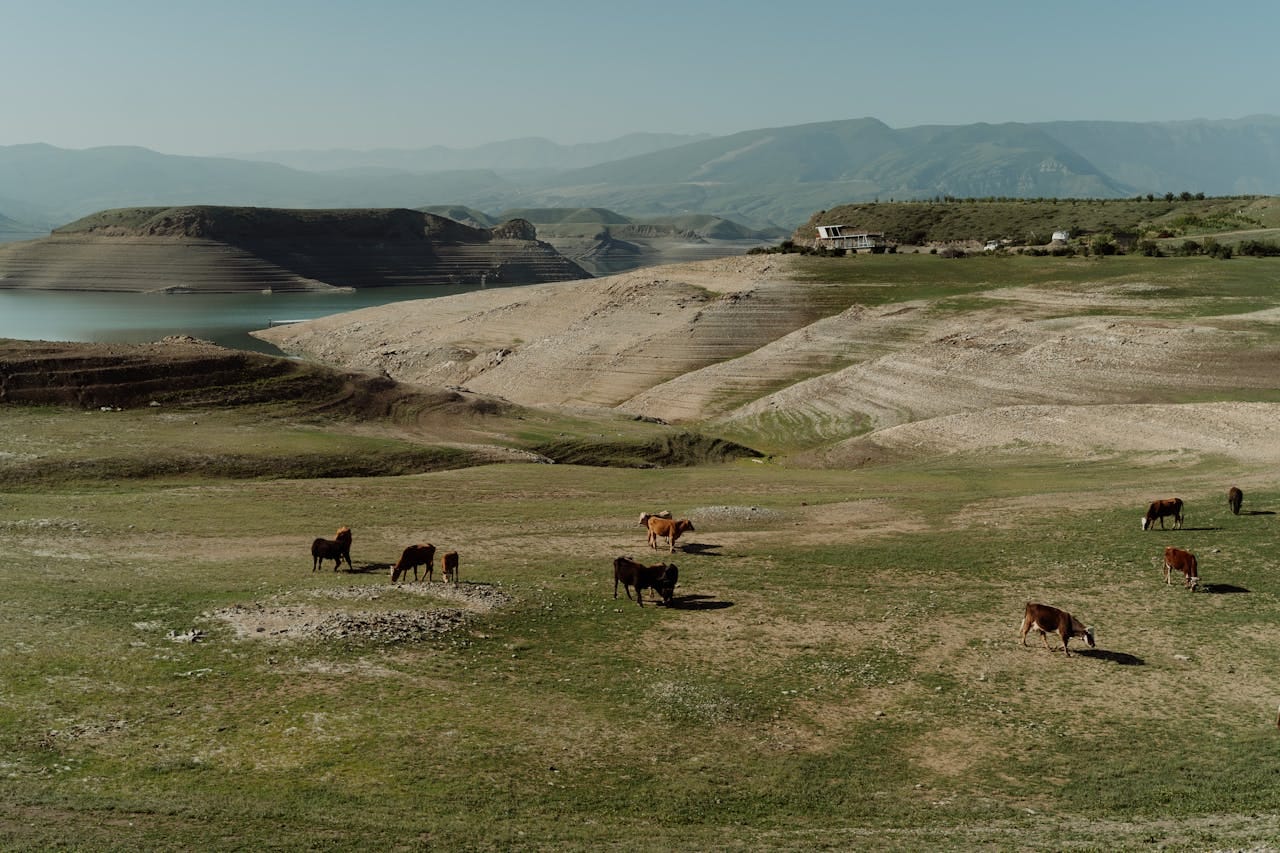
The Parthian Empire took control, then the Sassanid Empire. Rome tried to conquer but couldn’t. Like Georgia, Dagestan was “Persianized.” Over the centuries, every empire in Eurasia, save the Chinese or Japanese, came here looking for easy spoils. The Khazars, Genghis Khan, Tamur, Ottomans, Tsarist Russia.
The Land of Hayastan
The title is what Armenia calls itself. In ancient times, it was simply Hayk. The exonym, Armenia/Armin, was first written in Ancient Persian, then in Ancient Greek, around 450 BC.
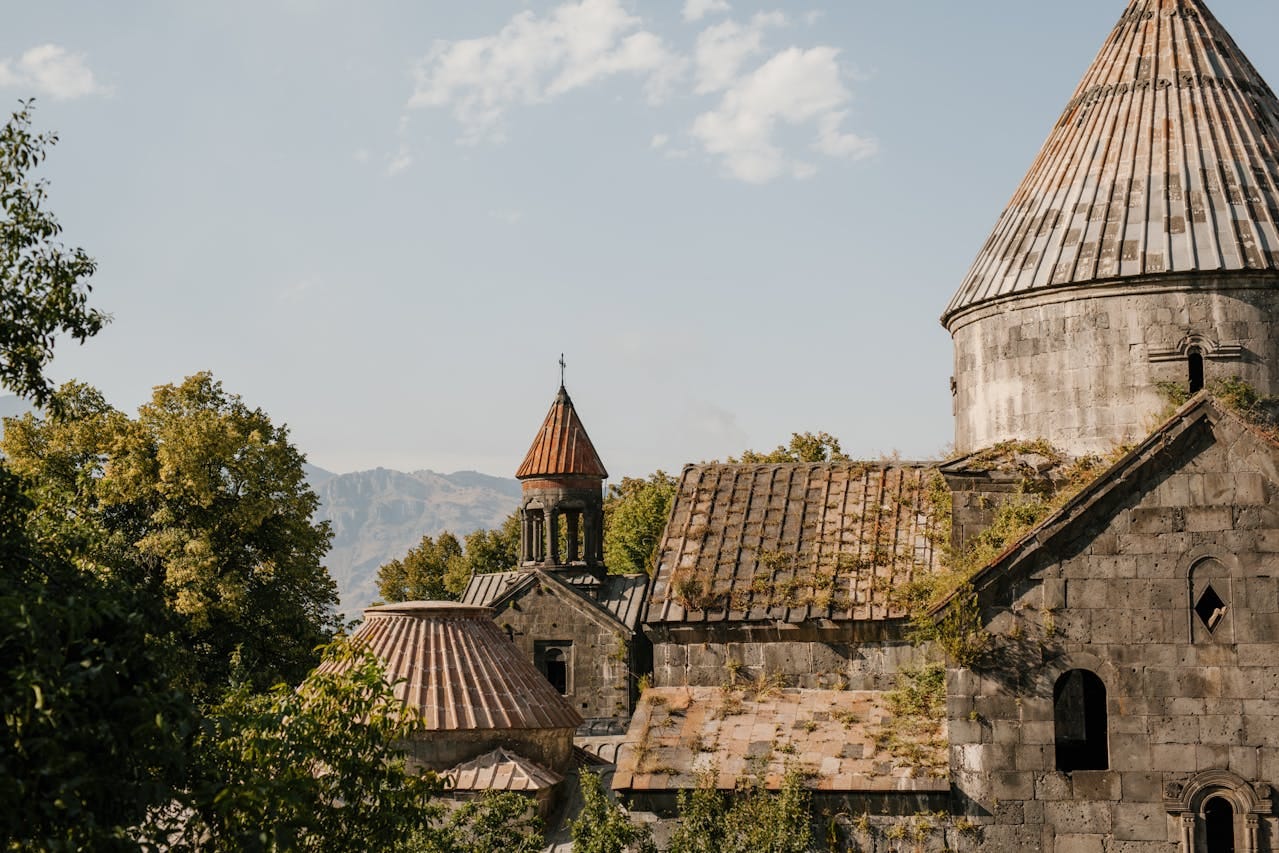
People have been living in what was Armenia and what is Armenia for 340,000 years. The oldest shoes, wagons, skirts, and winemaking artifacts all come from Armenia. As one of the oldest countries on earth that others have written about, Armenia’s history is a Caucasian one, and then some; it’s extremely complicated and convoluted. For example, the Assyrian Empire stretched to Armenia. Then the Achaemenid, Greeks, Parthians, Romans, Sassanid, Byzantium, Arabs, Seljuk, Mongols, Ottomans, Safavid, Afsharid, and Qajar dynasties of Iran, and finally, Russia and its successor state of the Soviet Union.
Languages of Armenia are Armenian, Yazidi Kurd, Kurdish, Greek, and Russian. And a smattering of Neo-Assyrian.
Land of the Soul
Abkhazia was part of Georgia for 1,000 years. Georgians say it is theirs; Abkhazians say no.

The Russian and English word, Abkhazia, we get from the Georgian language, Apkhazeti. Abkhazians call their land “land of the soul.” To the north is Russia; to the south and east, Georgia. History of Abkhazia: Persians, Greeks, Romans, Ottomans, and Russians. Usually, not always, as part of Georgia. Languages are Abkhaz, Armenian, Georgian, Russian (which is a lingua franca), and Greek. Most people are Orthodox, some Muslims, and thirdly, a smaller population of neo-pagans. Language family is Northwest Caucasian. Ossetian and Adygean are also in this family.
Land of the Alans/Ossetians
South Ossetia was part of Georgia; North Ossetia is part of Russia. Ossetians are descendants of the Sarmatians; themselves, they were part of the Scythian culture. This means that Ossetians are a Persian people speaking a Persian language. Most Ossetians are Orthodox, which is odd because most Northern Caucasus people are Muslim. But a large population is Uatsdin, the True Faith, the Ossetian original religion. Georgia to the south and southeast and west, Chechnya to the northeast and East, Russia to the north.
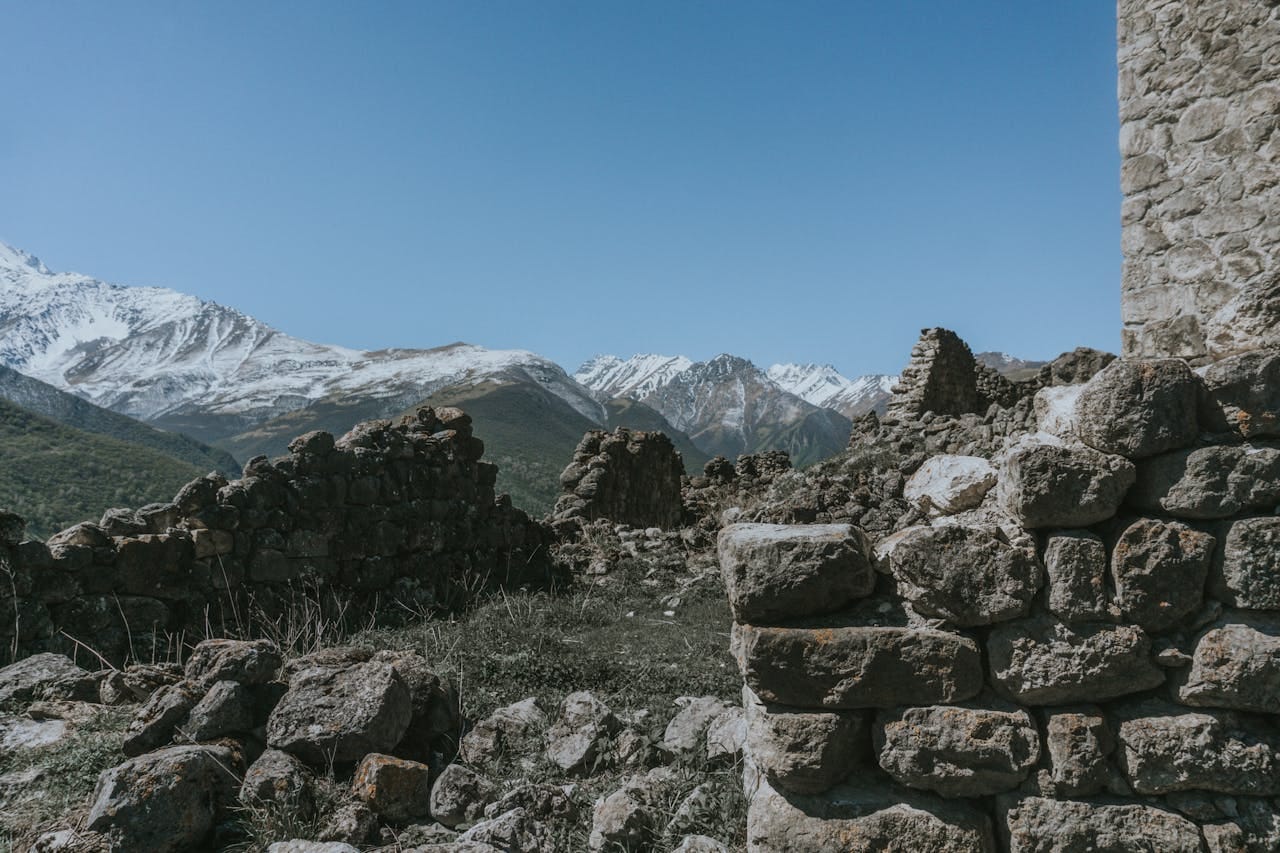
Land of the Nokchiy
Chechnya. The ancient natives of Caucasia are the Vainakhs; their forefather was Kavkaz, according to ancient Georgian chronicles. So, some say the Chechens are the most Caucasian of Caucasian peoples. Humans have been living in Chechnya for over 40,000 years. Like much of Caucasia, the Persians were here for a long time, and then the Ottomans. Lastly, the Russians. The main language is Chechen, 95%. Kumyk is a minority language. Mostly, almost all of Chechnya is Muslim. One of the last parts of the Caucasus to convert.
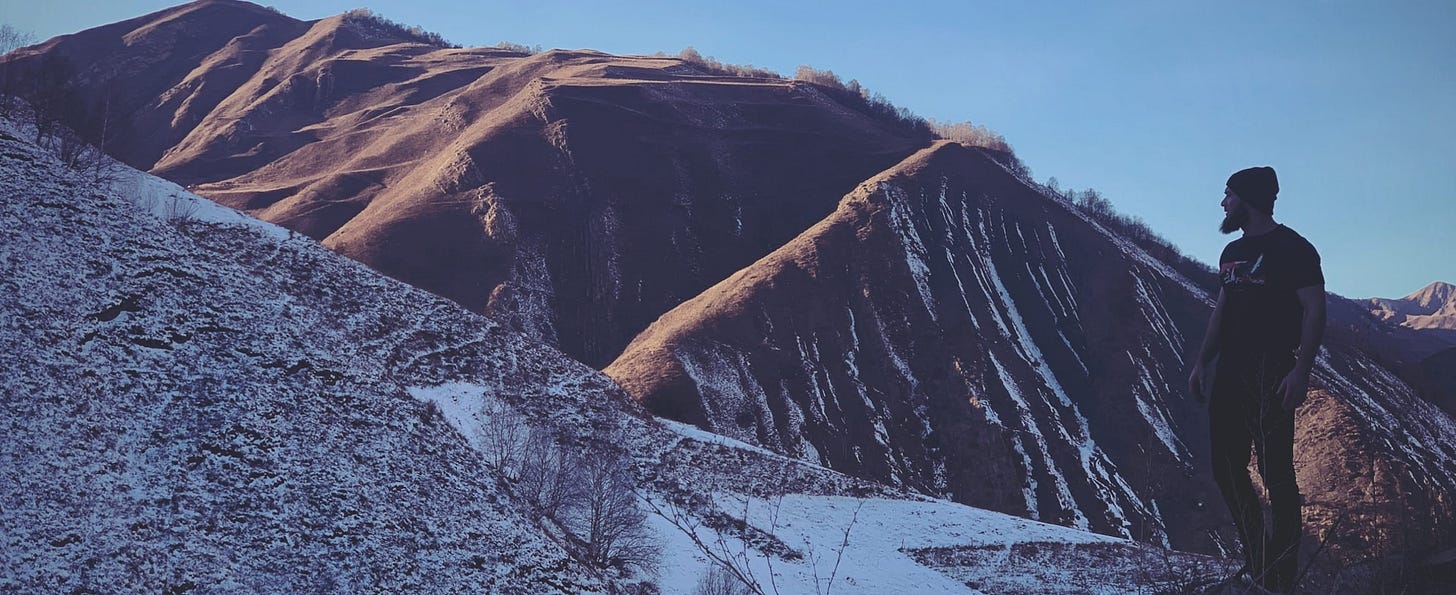
Land of the Holy Fire
Ancient history of Azerbaijan is, well, ancient. It goes back to the Stone Age. The Scythians came here, then the Persian Empire, then the Ottomans. In between were Tamerlane and, before him, Genghis Khan.
Azeri is a Turkic language. Not Persian. However, it’s a Persianized Turkic culture, or if you prefer to see it another way, a Persianized culture that speaks a Turkic language. To this day, the Zoroastrian New Year’s celebration is the largest native holiday. Languages here are mostly Azeri; Russian is spoken a lot; it is the lingua franca. The languages spoken here are too many to list. Some of the same names pop up here: Lezgin, Avar, Budukh, Talysh, Khinalug, Kryt, Juhuri, etc. A language spoken here is Tat, a Persian language. Offshoots of Tat are Armeno Tat and Judeo Tat. North of Azerbaijan is Russia, Georgia northwest, Armenia, and Turkey to the west and Iran to the south. Like other areas of the Caucasus, the Republic has many extinct and endangered languages. Some languages in the Caucasus are named after the valley they’re in. Go over the mountain to a new valley? Maybe a different language in a different language family.
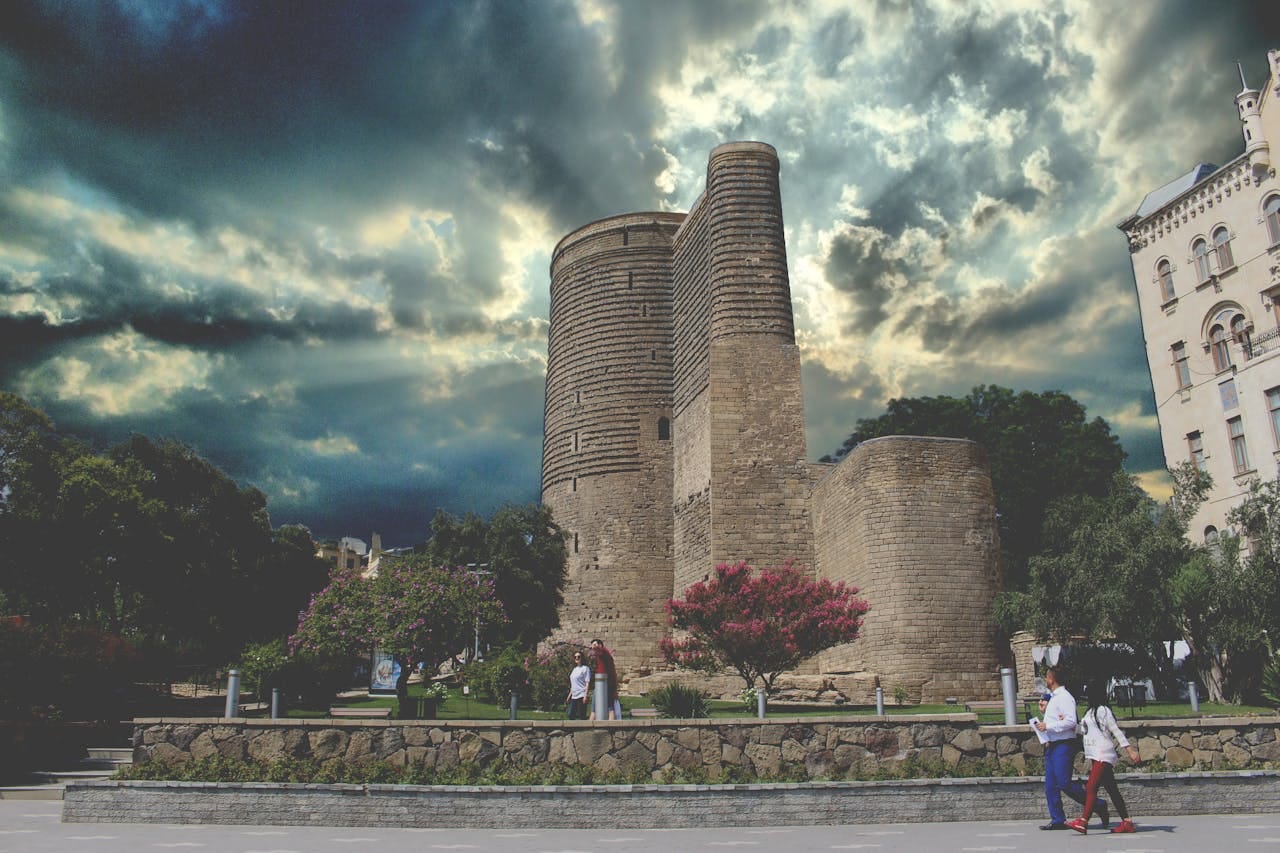
I’ve dealt with the largest cultures of the Caucasus, but by no means all. There are many dozens, over 50, groups in the Caucasus region, some with a few speakers, some like the Armenians or Georgians or Chechens with millions. Many with just a few thousand. Because of the pressures to learn the main language, whether it is Azeri, Russian, Armenian, or Georgian, in thirty years many of these languages will be extinct.
Imam Shamil
Before Khabib and Islam, before Ramzan Kadyrov and Khamzat, the most famous person from the North Caucasus was Imam Shamil, an Avar from Dagestan who was the bane of Russia’s imperial ambitions for 25 years. A mix of holy man, warrior, bogeyman, ogre.
It is my contention that, whatever one thinks of him as a friend, foe, evil, or good, we cannot subtract from his endeavors, which caused the most pain in Russia for a long time. If the American Indians were as numerous as the Northern Caucasus peoples, as warlike, America as we know it wouldn’t exist, or the “taming of the West” would have lasted much longer. Americans had no Dagestan, no Chechnya, and no Avar warriors. Comanches and Sioux were tough, yet not like this. Imam Shamil was the bugbear of the Russian Empire for three decades. Born in 1797, in what is today the village of Gimry, Dagestan, Shamil grew to be over six feet tall and, in a land of warriors, was known as a man’s man. By the time of his capture in 1859, he had been wounded 20 times and left for dead four times. 1832, the British press was enamored of the Chechen and Dagestani resistance to the Tsar and his minions. In 1832, it was Khazi Mula, Shamils friend and childhood companion, who was the leader of the resistance and Chief Imam of the Imamate, with Shamil as his military lieutenant and Hamzat Bekh as the religious second in command. At this time, Shamil was unknown to the world at large, except to what Suvorov called the eyes and ears of the Empire, the Cossacks. The Cossacks of the Terek Line most likely knew of Shamil before he became the bête noire of Russian warfare. It was at his birthplace where Shamil entered the Russian world and the greater world. It was here at the Siege of Ghimri that ten thousand Russian troops besieged Ghimri, an aul (village) located on steep cliffs, the defenses, line after line, of men hidden in crevices, waiting. The Russians brought up cannon on goat paths to assail the Murid stronghold. It was here that Khazi Mula was killed. Russian officers said that he leapt onto their bayonets. Many Murids (disciples) were killed; finally, a stone house was stormed, the Russians slowly taking potshots at any man who dared to poke his head out, the last of the Murids, one by one or two by two, emerging to run at the Russians and slashing, taking one or two with them in death. That day only two men survived; one was Shamil. A Russian officer had this to say about Shamil:
It was dark. By the light of the burning thatch, we saw a man standing in the doorway of the saklia, which stood on raised ground, rather above us. This man, who was very tall and powerfully built, stood quite still, as if giving us time to take aim. Then, suddenly, with the spring of a wild beast, he leapt clean over the heads of the very line of soldiers about to fire on him, and landing behind them, whirling his sword in his left hand [Shamyl, it will be recalled, was left-handed], he cut down three of them but was bayoneted by the fourth, the steel plunging deep into his chest. His face still extraordinary in its immobility, he seized the bayonet, pulled it out of his own flesh, cut down the man, and, with another superhuman leap, cleared the wall and vanished into the darkness. We were left absolutely dumbfounded. The whole business had taken, perhaps, a minute and a half.8
Afterwards, the Russians gloated, declaring the Caucasus theirs; the Caucasus, they said, had surrendered, submitted. But it was one man, Shamil, and his army of irregulars who waged war against them. The new Imam, Khamzat Bekh, lasted two years before he was killed. Upon his death, Shamil was declared the leader. He was no Khamzat Bekh or Khazi Mula. He was, for better or worse, extremely strict. There was no middle ground. Enemies were killed, or if lucky, beaten or whipped. His rule was so severe that often villages went over to Russia instead. Shamil was against customary law, adat, and for Islamic law and rule. The North Caucasus was a land of custom and tradition; Imam Shamil wanted total control.
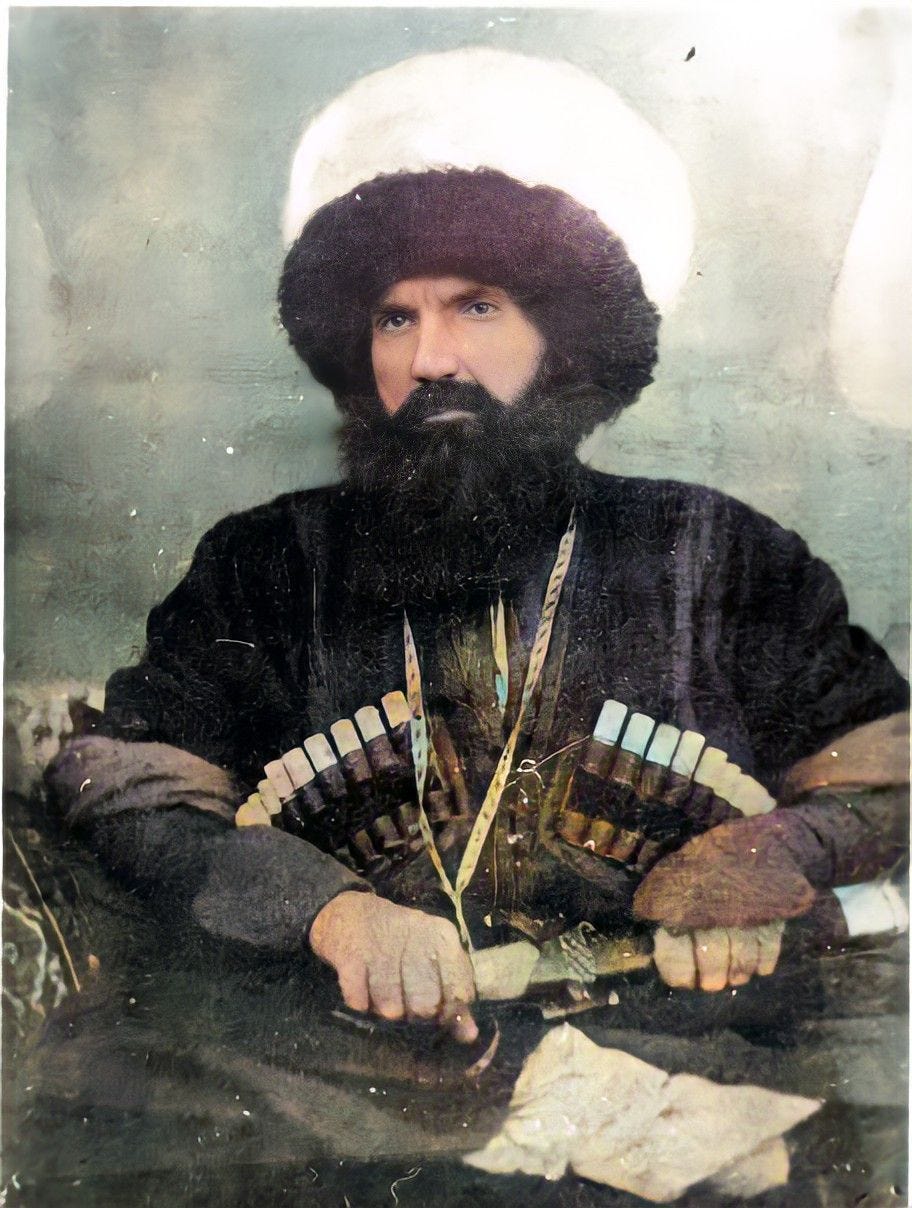
The Tsar defeated Imam Shamil and his Murids, slowly, by deforestation, literally cutting down forests where they could hide. By pacification, by annihilation. In 1859, Shamil surrendered. He then spent many years in captivity in Russia; before his death, he was allowed to make the haj and died while visiting Medina. Two sons joined the Russian army and became officers; two sons left and became officers in the Ottoman Army. To this day, Imam Shamil is remembered as the greatest North Caucasian who ever lived. The action of the Tsar can be likened to the US government capturing Geronimo or Sitting Bull and then bringing their entire families to an estate in, say, Ohio, paying for their lives and livelihoods.
It is unknown how many hundreds of thousands of Chechens and Dagestanis were killed in the Russian pacification of the North Caucasus. It’s also unknown how many Russian soldiers were killed. The heroics of the Kavkaz warriors entered Russian imagination as a frightening fact and ended as literature. First Pushkin, then Lermontov, and then Tolstoy brought the region and its heroes to public attention. For the North Caucasus, Imam Shamil is still fact, and of course, legend.
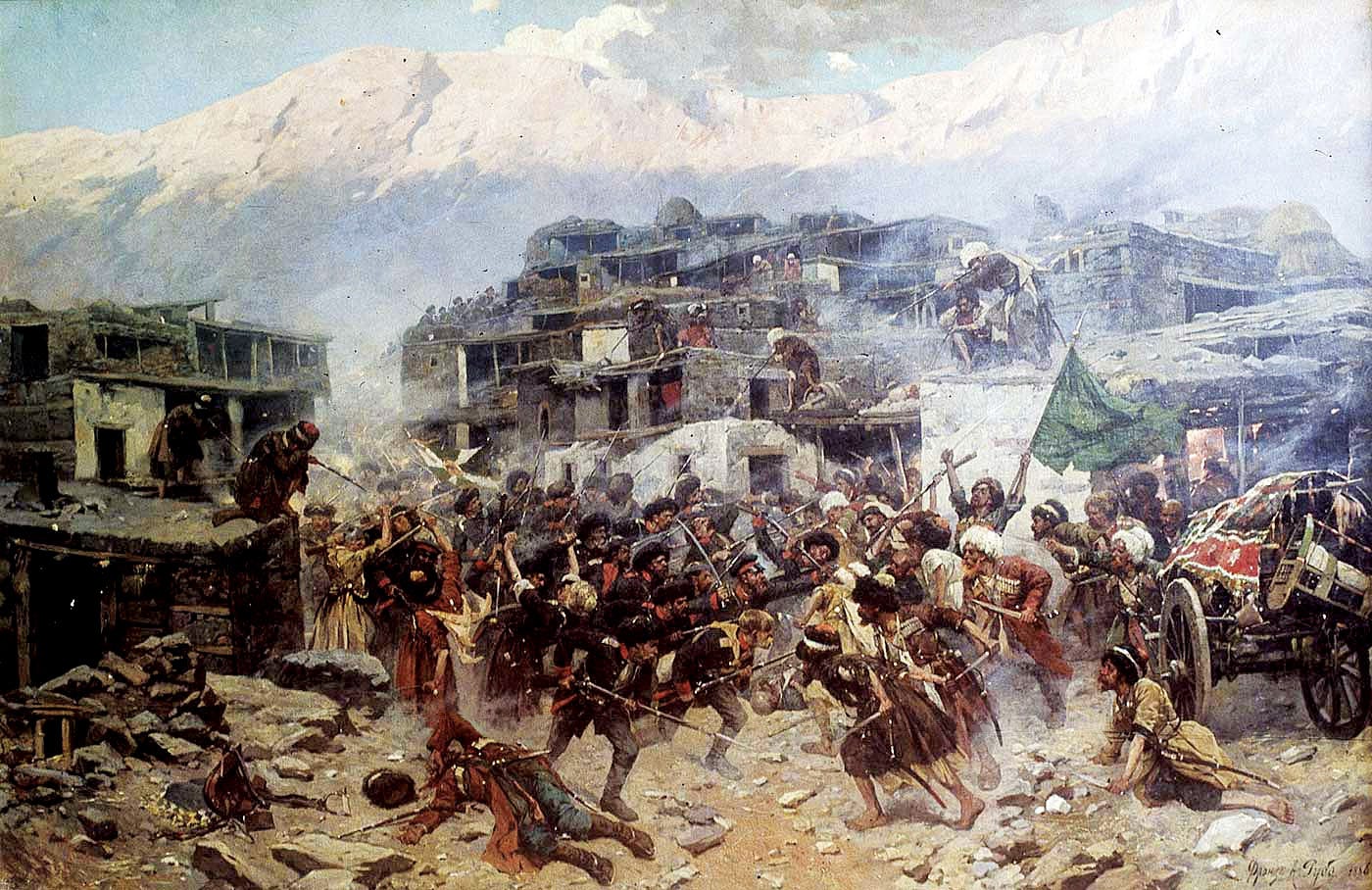
A list of top Soviet wrestlers shows almost every one as being from the Caucasus, either a Georgian, Abkhaz, Ossetian, Dagestani, etc. Notably, the best Russian wrestler, and arguably the greatest wrestler from anywhere, at any time in the modern era, is Karelin… Who was from Siberia and, as far as anyone knows, isn’t from the Caucasus. Fedor Emelioneko, the famous MMA fighter from Stary Oskol, Russia, was trained by Volk Han, a not-so-famous Dagestani coach, whose real name is not so cool-sounding, doesn’t sound as if he’s a character in an Ian Fleming novel. Here, try to say it; say it fast: Magomedkhan Amanulayevich Gamzatkhanov. Volk Han is much better. Volk Han has a nice ring to it.
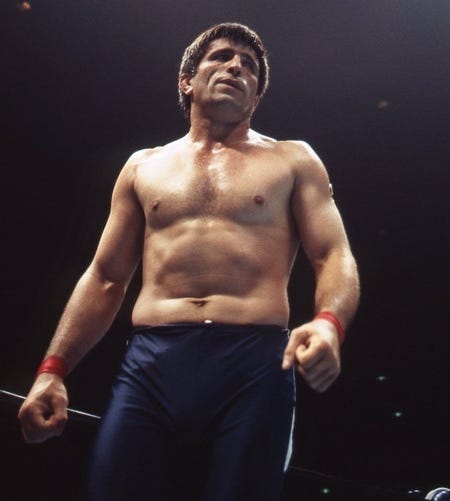
Wrestling isn’t just popular in the Caucasus. Wrestling has been practiced and loved as a sport since we first came down from the trees or were made by God or the gods. In the Epic of Gilgamesh, Gilgamesh wrestled Enkidu; in the Old Testament, Jacob wrestled an angel; in fact, Israel means to wrestle with God; Thor wrestled; Greek philosophers wrestled. In almost every country there is a tradition of wrestling. In the Caucasus, wrestling is taught at an early age. It is the sport of these people; no matter the religion, no matter if their language is an isolate, an Indo-European one, none of this matters. It is the region that matters. For decades, Caucasus wrestlers have ruled the Olympics and the general wrestling world. We are all products of our class, sure, our DNA, of course, our tribal blood, our lifestyle choices, and the particular piece of earth we live in. These things should be better known.
Some slackness of ritual, we are told, that hurt the feelings of the dii montes, the gnomes of the hills, allowed Rome to fall to the barbarians. These gods of place were genii, spirits of a place. All folklore knows them, and when a hero died who had wound his fate with that of a place, he joined its genii and thereafter partook of its life. Our word ‘congeniality’ means kinship with the soul of a place, and places have souls in a way very like creatures.
— Guy Davenport
Wrestling, either the local folk style, Greco-Roman, or freestyle, is extremely popular in all the countries and surrounding regions of the Caucasus. For decades, these peoples have won more medals and competitions than any other ethnic groups in wrestling. So, it’s only logical that they’d take the love of wrestling into a professional arena; the most popular arena today isn’t in Rome; it’s wherever you are sitting watching the UFC.
In the beginning, fighters in the Ultimate Fighting Championship had one martial arts training: the Gracie family, BJJ; Ken Shamrock, shoot wrestler; Kevin Rosier, kickboxer; Patrick Smith, taekwondo; Gerard Gordesu, savate; Zane Frazier, karate … there were boxers and even sumo wrestlers.
All of the above fighters, and more, were at the first UFC event in Denver in 1993. For the next 13 years, the fledgling “human cockfighting” company — as John McCain called it — struggled to survive and evolved from a world of one-dimensional fighters, trained in, usually, one discipline, with nary a rule, to an organization by 2006 that had most of the rules we see today and, most importantly, well-rounded fighters. One of the first was Arizona native Don Frye, a legend of the UFC; he also fought in the Japanese promotion, Pride. Trained in wrestling, judo, boxing, today, most fighters in the UFC are well-rounded and know at least a couple of martial arts. To win, a fighter must have a ground game, wrestling, BJJ, grappling, and sambo, as well as some training for the stand-up game: boxing, Muay Thai, kickboxing, and karate. The more one knows, the better it can be for the all-around game. For many years, the dominant martial art was Brazilian Jiu Jitsu, a martial art invented by the Gracie brothers Helio, Oswaldo, Gastao Jr., George, and Carlos Gracie. Then, Japanese judo was called jiu-jitsu; later, the Japanese government ordered that this martial art be called, officially, judo. The main difference between BJJ, or Gracie Jiu Jitsu, as it was sometimes called, is that in judo there are more throws and sweeps, trips in the clinch position, standing close, and holding onto the opponent. In BJJ, the emphasis is on the ground, with submissions and locks. To this day, Brazilian Jiu-Jitsu is a dominant martial art in the UFC. Arguably, one of the promotions and the MMA sports’ most dominant fighter ever is Jon Jones, a well-rounded fighter. Fedor Emelianenko, a sambist from Stary Oskol, Russia, who spent much of his career in Pride and whose trainer was Volk Han, was also very well-rounded. Sambo, judo, boxing, Emelianenko. Jones wrestling, boxing, BJJ, kickboxing Other well-rounded champions: Georges St Pierre, B. J. Penn, Anderson Silva, Mauricio Rua, Matt Hughes, Alexander Volkanovski, Demetrius Johnson, and dozens more. So many fighters with deep knowledge of BJJ and other martial arts. And now, something different.
The Caucasus comes to us
Think of martial arts as a mountain, at the base are the old school brawlers and one-trick ponies, then, we go higher up, to BJJ, good striking, men with more than one arrow in their quivers, we go higher now, we are in the Caucasus. The fighters now are fighters of the Apocalypse. They are the Last Man. The Apocalypse has visited them since the world began … there is no surrender, no tapping. They will bring you to the earth. Mother earth, says the wrestler, wants you broken below me, surrender. They do it by playing chess with their bodies, we have the technology, they are of the mountains and the rocks and earth. They are the Bill Gates, Steve Jobs, the Elon Musks of the martial arts world. They come with unpronounceable names, with a zeal to overthrow the Kingdom of Violence … with violence.
For its history, the Caucasus was the area fought over, attracting imperialistic powers from the south, the east, the west, and the north. The men had to know how to fight and know how to fight at an early age. And not just with their hands, also with guns, with knives. On January 18, 2025, in the most popular mixed martial arts promotion in history, the top two fights were almost all fighters from the Caucasus. One, Armen Tsarukyan, from Armenia, dropped out with an injured back. His opponent was Islam Makhachev from Dagestan. The co-main event also had Merab Djugashvili, from Georgia, who fought Umar Nurmagomedov, also from Dagestan. Islam won his fight easily against a Brazilian, Renato Moiceanu. Merab won against the favored Umar. Of course, these aren’t the only fighters from this region in the UFC; one of the most feared fighters is from Chechnya, Khamzat Chimaev; one of the best fighters of all time, Khabib Nurmagomedov, is an Avar from Dagestan. In addition, there is Ilya Topuria, an ethnic Georgian from Abkhazia, and Islam is an ethnic Lak from Dagestan. Retired fighter Zabit Magomedsharipov — whose fights looked like something cut from The Matrix, with his insane punches and kicking, is an ethnic Akhvakh. In addition to grappling,wrestling, almost all of the Caucasus fighters have a base in the Soviet martial art, Sambo( Russian acronym for : самозащита без оружия) or Combat Sambo.
All weight classes of the UFC currently have a Caucasian somewhere. Most are Dagestani, but there are a couple of Ossetians, Georgians, Armenians, and Chechens. Today’s UFC fighters are better than the fighters of fifteen years ago; it’s a sport that evolves quickly, and if one wants to rise to the top, one must evolve and learn from the best. With the rise of BJJ in mixed martial arts, most fighters saw it as a necessity to learn it. Will the Caucasian fighters take over? Maybe. If so, will Americans and Brazilians come to Makhachkala to learn Dagestani wrestling? Probably not. But Dagestan may start exporting their trainers.
Whatever happens, it doesn’t seem to be a rare occurrence. After dominating world wrestling for so long, I expect many will come to the UFC. In wrestling there is honor and glory, but one needs money. If Abdulrashid Sadulaev, the current, for my money, best wrestler alive comes to the UFC, I don’t think his rise to the top of the heavyweight division will take long. The Dagestani is freakishly explosive and powerful. He is no god from the Nart Sagas, he will need to learn striking. He has the potential to be a heavyweight Chimaev. And who, in the UFC, is as exciting as Chimaev? Not many.
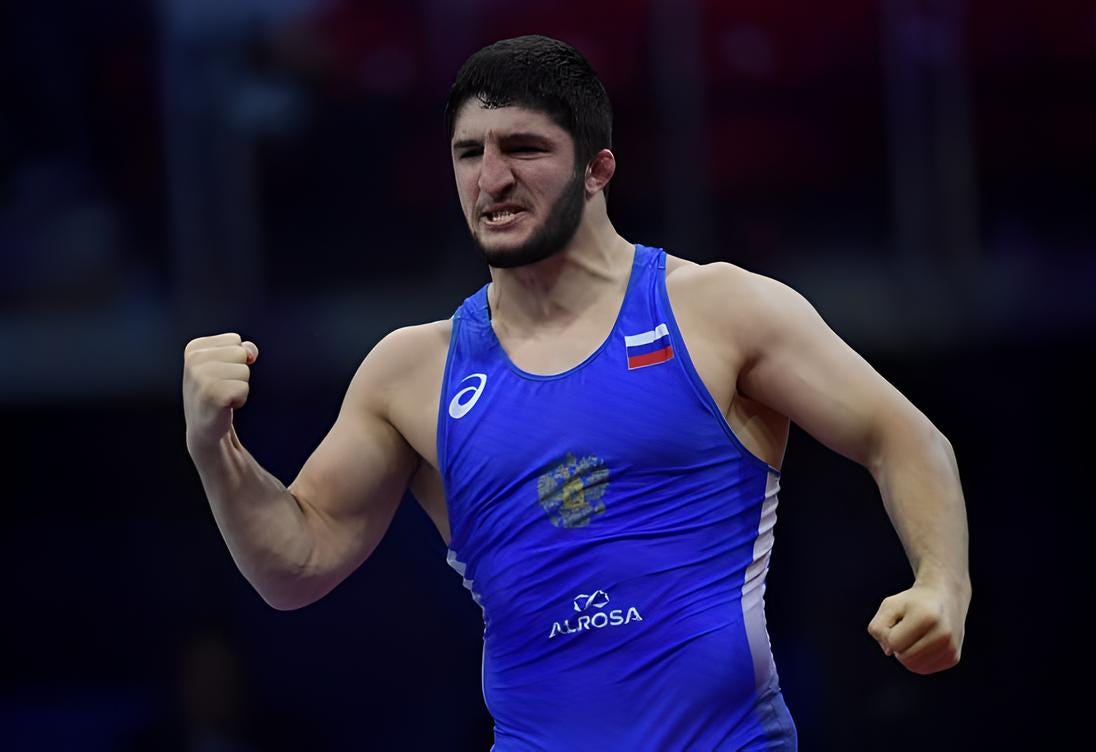
In a sport like mixed martial arts, ego seemed a part of the game. Trash talk, chest beating, insults. Most of the time, when the fight was over, they shook hands and moved on. The Dagestanis are different. Humble outside the octagon, inside they are unstoppable; they are ferocious. At the moment, many of them are unbeaten. The only way to win is to knock him out. From Lermontov:
“They don’t seem to know when they ought to die — indeed, these villains can hardly ever be killed. They are a people without the slightest idea of propriety.”
Of all the peoples of the Caucasus, it was the Northern Caucasians the Wehrmacht prized most. The Persians feared most. Russians themselves honor their contribution, their ferocity, their valor.
Training in Dagestan isn’t for the party animal or the social butterfly. Mountainous, rugged, a strict, conservative republic where fighters often train with family and close friends. The support of the family is paramount. A fighter doesn’t just represent his country, his people, but he represents his tribe, his family.
In the long, long history of the Caucasus, the fight was brought to the Caucasus, their people were stolen, in many instances they rose above and conquered. With the new sport of mixed martial arts, in this too, they will excel. They will dominate.
Grayson, Assyrian Royal Inscriptions, vol. 1, no. 527 (1972), p. 81. The Assyrian name “Uruatri” is here a toponym, while the name “Urartu” designates, as of the ninth century BCE, a political entity.
Farr, “The Application of Statistics to Naval and Military Matters,” The Journal of the United Service Institution, 3 (1859), pp. 209–24.
Hippocrates, On Airs, Waters, Places (London: Wyman and Sons, 1881), pp. 97–101.
Leo Tolstoy, The Cossacks.
Lesley Blanch, The Sabres of Paradise: Conquest and Vengeance in the Caucasus (1960).
Johann Blumenbach, De generis humani varietate nativa. 3rd ed. Göttingen: Vandenhoek and Ruprecht, 1795.
Mark Twain, The Innocents Abroad, Chapter 34.
Lesley Blanch, The Sabres of Paradise: Conquest and Vengeance in the Caucasus (1960).
https://www.arktosjournal.com/p/a-history-of-violence-in-the-caucasus
